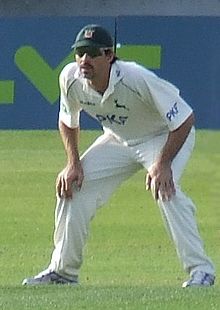A look back at the Australia v New Zealand 1997/98 Test series
Marco Trevisiol |
When New Zealand toured Australia for a 3-Test series at the start of the 1997/98 summer it would be fair to say that the anticipation for a series between these two sides had rarely been lower.
All signs pointed to a cakewalk for Australia. They had gone from strength to strength as a Test side under the captaincy of Mark Taylor in the mid-1990s. Not only were they dominant at home but under him they’d won away in the West Indies, South Africa and England. For the first time since the mid-1970s, Australia were clearly the No. 1 Test side in the world.
In contrast, New Zealand’s previous few years as a Test side had been their worst in decades. Seemingly unable to recover from the loss of greats like Richard Hadlee & Martin Crowe, the side lost consistently home and away with multiple captains being dumped. A home series win to Sri Lanka in early 1997 under young new captain Stephen Fleming had been their first Test series win in years and provided some hope but winning away anywhere seemed something in the distant future for them.
The early tour matches for New Zealand were disastrous as they suffered humiliating innings losses to both Queensland and New South Wales. But on the morning of the opening Test at the Gabba there was a ray of hope for Fleming as the conditions were overcast and the pitch green enough to suggest plenty of opportunities for pacemen. Maybe things could turn for NZ if Fleming could win the toss and send Australia in… which he did!
And initially it seemed New Zealand’s plan was working superbly as Chris Cairns ripped through the Australian batting lineup to have them 4/52 before lunch. However, captain Mark Taylor held firm (only just out of a horrendous 12 month batting slump that threatened his career) to score a century and with impressive help from Ian Healy and Paul Reiffel (in the best batting form of his career), Australia made 373.
While New Zealand fought on manfully over the next few days, their inability to skittle Australia on Day 1 was the decisive factor in the match.
New Zealand didn’t wilt initially and posted an impressive 349 in response, the highlight of which was debutant Craig McMillan fearlessly straight driving Shane Warne (who’d tormented New Zealand mercilessly in previous encounters) for six.
But once the Test had become a five day attritional grind the talent disparity between the two sides meant it was a question of when, not if, Australia would break New Zealand’s resistance.
As it was, Australia had to wait till just before lunch on Day 5 to do this. 30 minutes before lunch New Zealand still had 9 wickets in hand and looked a good chance to salvage an impressive draw. But Glenn McGrath, fairly quiet by his standards to this point, produced one of the innumerable classic fast bowling spells that saw him destroy the New Zealand middle order with 4 wickets in half an hour. Australia had the match won just before Tea a couple of hours later.
As disappointing as the final day at the Gabba was, New Zealand and their captain Fleming could take heart from performing above expectations and making their No. 1 ranked opponents work hard on all 5 days to finally triumph. Alas, the 2nd Test in Perth was to provide no such comfort for the tourists.
At first glance, it appeared the Test at the WACA would provide greater opportunities to challenge Australia as they were to be without their outstanding paceman Glenn Mcgrath due to injury. As a result, Australia’s pace attack was the not particularly imposing trio of Michael Kasprowicz, Paul Reiffel and debutant Simon Cook.
In addition, the Australian side was distracted throughout the Test by an ongoing dispute with their cricketing board (then called the Australian Cricket Board) over pay and conditions for not only the top national players but the long-term state players as well who were essential to the strength of the national side. At one stage it looked as if the entire group of Australian players would vote to strike.
Yet despite this major distraction and being below full strength, Australia put in one of their most complete Test performances of this period.
New Zealand batted first and were dismissed before stumps for just 217 with the highlight of the innings being that almost every dismissal was due to a brilliant piece of Australian fielding. This shouldn’t be a surprise as in a decade of excellent Australian fielding sides, the side they had during this season was arguably the best.
Despite a stuttering start and no player managing to score a century, Australia’s total of 461 looked more than enough to ensure a comfortable victory. Especially as the WACA pitch had begun to crack up severely so that by Day 4, the hapless New Zealand batsmen were confronted with cracks on a good length on off-stump that were just waiting to be exploited. Surprisingly, it was debutant Cook who exploited it best as he bagged 5 wickets and ensured the tourists were humiliatingly defeated by an innings and 70 runs.
Having lost its two Tests and three tour matches (three of them by an innings), it wouldn’t have surprised if New Zealand went into the final Test in Hobart demoralised and offering little resistance. But a couple of things went in their favour.
Firstly, the weather in Hobart was unfavorable for much of the match so that by Day 4, a draw looked a near certainty, something that the tourists would gladly take after so many defeats.
Secondly, and far more significantly, Stephen Fleming decided to take the match up to Australia by declaring his side’s first innings late on Day 4 despite being a large amount of runs behind and having plenty of wickets in hand. In effect, Fleming was challenging Taylor and his side to make a game of it and give them something to chase instead of letting the match drift out to a dreary draw.
Fleming’s surprise move did something that hardly ever happened to a Mark Taylor led Test side; it made them look defensive and tentative. Instead of getting quick runs to ensure the maximum amount of overs to get New Zealand out, Australia lacklusterly batted throughout the opening session on Day 5 and declared at lunch, not even trying to have a short pre-lunch burst at their opponents. Taylor and the side was criticised for being so conservative in setting a target in what was a dead rubber, something that must’ve galled a side that had constantly played attacking and aggressive Test cricket.
As it was, Australia almost grabbed victory anyway (and may have won had they showed more initiative). Chasing 288 in two sessions, New Zealand started brightly but Shane Warne (again having another excellent series versus New Zealand) ripped through the middle order so that the final pair had to defend for almost 40 minutes just to escape with a draw.
But the result really wasn’t the main thing New Zealand could take out of the match. With his bold and challenging declaration, it seemed that the side in Stephen Fleming finally had the leader that could lead them out of the dark days of the mid-1990s. And so it would prove, as Fleming would have a long and fruitful career as New Zealand Test captain and be widely regarded as of the most inventive leaders of his era and one of the country’s best ever Test captains.
As for Australia, while this would be well down the list of most memorable Test series triumphs in the 1990s, it is worth noting as a demonstration of how by the late 1990s that no matter what players were missing or what problems they had off field, they had such talent, work ethic and culture that winning Test series at home became as natural as breathing air. Indeed it would be over a decade before they were to lose a Test series at home.





Leave a comment